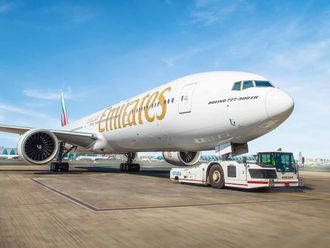
Dubai: Etihad Airways, the eight-year-old UAE flag carrier, has become profitable, reporting a $14 million (Dh51.4m) net profits in 2011 on $4.1 billion (Dh15b) revenues – a 36 per cent growth over $2.98 billion revenues recorded in 2010.
The results, audited by global accounting firm KPMG, included earnings before interest, tax, depreciation, amortisation and rentals (EBITDAR) of $648 million. It’s full year earnings before interest and tax (EBIT) stood at $137 million.
“The record result exceeded the airline’s 2011 target, which was to break even,” the airline said in a statement.
This makes Etihad the third most profitable Gulf Arab carrier after Emirates Airline and Air Arabia.
8.3 million passengers 2011
The airline carried 8.3 million passengers last year, up 17 per cent on 2010 which was 7.1 million, with an average seat factor of 75.8 per cent, nearly two percentage points higher than 2010 (74.0 per cent).
At the end of the year, the airline had 64 aircraft served by 9,038 employees.
James Hogan, President and Chief Executive Officer of Etihad Airways, termed this as ‘a historic day for Etihad’ and ‘an amazing achievement for an airline just eight years old’.
“Five years ago we said we would be profitable by 2011. Despite the global financial crisis, continued high oil prices, regional instability and natural disasters, we have delivered,” said Hogan – the ‘turnaround guru’, who earlier had turned around the loss-making Gulf Air into a profitable one, just before joining Etihad Airways in 2006.
“The mandate from our shareholder was to create an airline that is best in class, operates to the highest safety standards, and makes money – and we have achieved this mandate,” he said.
The airline’s growth of available seat kilometers (ASK) rose from 45.2 billion in 2010 to 51.0 billion, up 13.0 per cent. Etihad Crystal Cargo revenues are up 25.7 per cent to $651 million ($518 million) on tonnage up 17.8 per cent to 310,188 tonnes (263,313 tonnes), the airline said.
Etihad also witnessed an increase in total aircraft departures, from 57,534 to 62,735, with a technical dispatch reliability of 99 per cent.
Eight new codeshare agreements
Last year, it concluded eight new codeshare agreements, taking Etihad Airways’ codeshare partners to 35 airlines, which increased its worldwide network to 259 destinations – more than any other Middle East air carrier.
The airline added five new routes – Bangalore, the Maldives, the Seychelles, Chengdu and Dusseldorf last year.
Etihad Airways’ successful partnership strategy intensified, with its first equity investment in another carrier – Airberlin, Europe’s sixth largest airline, which was announced in December 2011. The airline invested nearly $95 million for nearly a 30 per cent stake in the airline.
“This was a game changing move for Etihad Airways, adding 157 destinations and giving us access to 35 million new passengers.
Growth
“The Airberlin deal will be our most important catalyst for growth in 2012. It has given us instant access to Europe’s largest travel market, and will have a major impact on revenues in 2012, with an expected contribution of up to $50 million.
“And of course, 2011 marked the first full year of Etihad’s strategic partnership with Virgin Australia, which offers 45 destinations in Australia and the Pacific, and boosted revenue by 700 per cent over what we achieved with our previous Australian airline partner.
“We will continue to look at opportunities in 2012. Already this year we have announced a second equity investment, in Air Seychelles, which is an important step towards growing our operations in the increasingly popular leisure markets of the Indian Ocean and Africa.”
At the end of 2011, the company had 9,038 employees, up 15.1 per cent on 7,855 in 2010, with more than 120 nationalities represented. Etihad Airways’ successful Emiratisation scheme continued, with Emiratis now making up 18 per cent of the headquarters workforce.
Investing heavily
“We remain a business that is investing heavily in new routes, in new aircraft and in new infrastructure,” said Hogan. “In 2012, we will add seven aircraft and have already announced plans to extend our network in Asia and Africa.”
“In January, we commenced operations to Tripoli, and Shanghai and Nairobi will follow – all in the first quarter. In July, we will add an additional African destination – Lagos – and will continue to announce new destinations in the coming months.”
Etihad Airways ordered 100 new aircraft and 105 options and purchase rights at the 2008 Farnborough Air Show.
This gives flexibility in its network growth, enabling it to meet passenger demand over the next 10 years. To date, Etihad has raised $5 billion in external fleet financing, through a portfolio of 41 different financial institutions.










